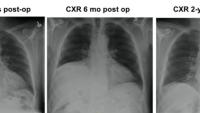Peripheral Nerve Surgery
How the Procedure Works to Heal the Nerves
During surgery, the nerve is exposed, and the constriction is identified under the operating microscope. At that point, 2-3 longitudinal incisions are carefully made in the nerve under high magnification. This procedure is called “internal neurolysis,” and its purpose is to release the scar and decompress the nerve. Once the pressure is relieved in the nerve, the nerve can recover. This recovery process can take a year or more, depending on the distance the nerve needs to recover before reaching its target.
Neuralgic Amyotrophy and Nerve Entrapments
Some patients with neuralgic amyotrophy develop swelling along the affected nerves. When this occurs, the swollen nerve can become compressed by surrounding structures. This typically occurs when the nerves cross joints or pass alongside rigid structures such as fascia, bone, or tendon. These nerve entrapments can cause pain, numbness, and weakness along the affected nerves. Common examples of nerves affected in this way include the median nerve at the wrist, ulnar nerve at the elbow, and radial nerve at the forearm.
Fortunately, nerve entrapments can be treated surgically. As for the hourglass constrictions described above, patients with neuralgic amyotrophy who have persistent deficits after 6 weeks can undergo nerve imaging to assess whether a nerve entrapment is present. Nerve ultrasound and MR neurography can reveal the presence of the nerve swelling and compression seen in nerve entrapment. If entrapment is discovered along a nerve that is not recovering, then surgical decompression of the nerve is indicated.
How the Procedure Works to Heal the Nerves
At surgery, the affected nerve is exposed, and the tissues compressing it are divided. This relieves the pressure on the nerve and allows it to recover. In cases of bony compression of the nerve, the nerve can be moved to another location to relieve the pressure. This is called a “nerve transposition.” After nerve decompression, the recovery process can take a year or more, depending on the distance the nerve needs to recover before reaching its target.
Neuralgic Amyotrophy and Diaphragm Paralysis (embed video again)
Diaphragm paralysis is commonly caused by loss of function in the phrenic nerve. The phrenic nerve is a motor nerve that originates in the cervical spinal cord. The nerve fibers exit the spinal cord via the C3-5 nerve roots and connect to the upper portion of the brachial plexus at the C5 nerve root level. From there, the different nerve root contributions coalesce to form the phrenic nerve, which then runs inferiorly along the surface of the anterior scalene muscle. It then enters the chest at the thoracic outlet, runs across the surface of the heart and great vessels in the chest, and enters the diaphragm muscle at the base of the chest.
Sometimes, the phrenic nerve can be affected by neuralgic amyotrophy. Patients with phrenic nerve involvement may get shortness of breath with exertion (“exertional dyspnea”). This is the most common patient complaint that prompts a visit to their physician. Subsequent testing reveals diaphragm paralysis when the phrenic nerve dysfunction is severe. Chest X-rays will show an elevated hemidiaphragm, the classic finding for a paralyzed diaphragm. Other studies, such as pulmonary function studies and sniff tests, can help confirm the diagnosis. However, it is essential to localize the site of phrenic nerve involvement so that the underlying nerve problem can be corrected.
Recovery Times
Although most patients with neuralgic amyotrophy and phrenic nerve dysfunction get better without treatment, some patients do not recover spontaneously. In these cases, an hourglass constriction may affect the phrenic nerve. If nerve ultrasound and/or MR neurogram reveal a phrenic nerve hourglass constriction, then internal neurolysis to release the constriction is performed. Once the pressure is relieved on the phrenic nerve, then the nerve can recover. This nerve recovery then allows the diaphragm to begin working normally again. This recovery process generally takes 1 year. When the phrenic nerve recovers, the patient can resume breathing normally without shortness of breath.
